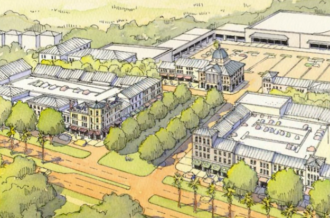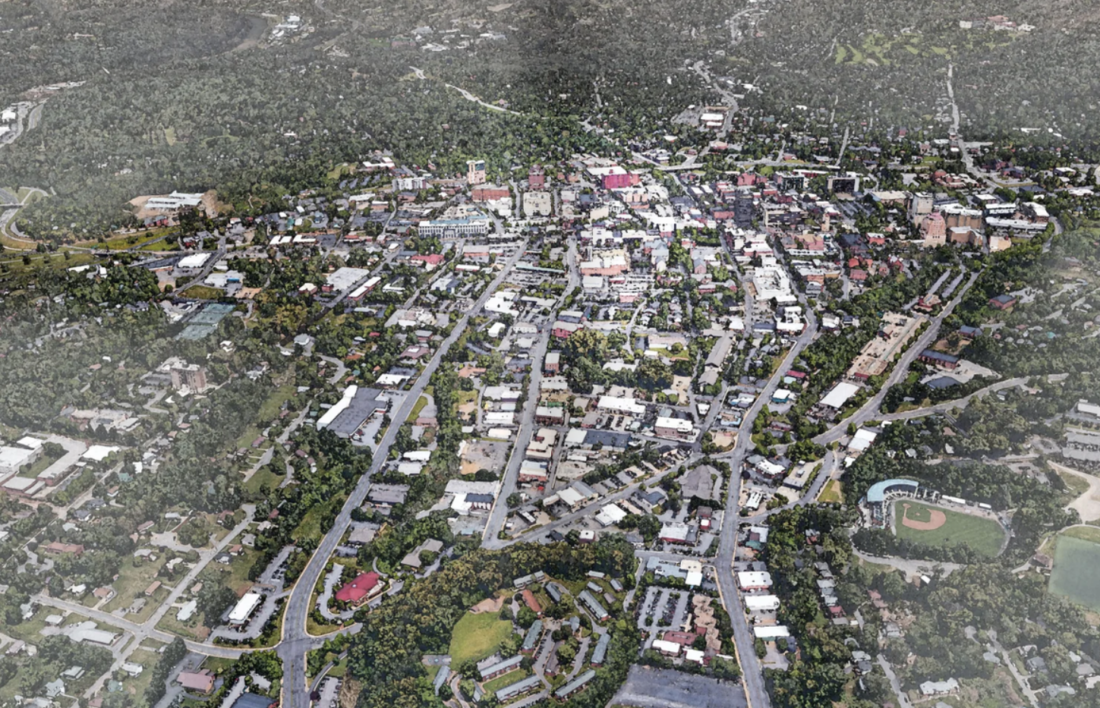Most Asheville residents don’t care about zoning changes. That is, until it’s happening in their own backyards.
Just ask Rick Freeman, president of the Coalition of Asheville Neighborhoods, who encouraged his neighbors to speak out when Asheville City Council was considering a 2018 proposal to redevelop the former Sears property at the Asheville Mall into apartments, commercial buildings and a movie theater.
Or ask Moira Goree, a lifelong Asheville resident who participated in the 2018 Council meetings that led to new rules for short-term vacation rentals after she repeatedly found herself displaced by new Airbnbs.
Or ask the environmental activists who, after years of lobbying Council for stricter requirements for preserving the city’s tree canopy, in September saw rule changes to require tree protection in residential and commercial areas.
Zoning may not deliver the same zing as the hot-button issues that dominate 2020’s competitive election cycle, but it’s among the most crucial discussions Asheville leaders and residents face as the city grows. Soon, three of the five candidates running for Asheville City Council will cast votes on development and land use — including downtown hotels, environmental protections and growth along major roadways — and each candidate brings different priorities.
“Asheville is going to grow,” says candidate Sage Turner. “We owe it to ourselves and future generations to plan now for what could be a doubling in size in future decades.”
Mapping it out
Asheville’s main tool for regulating land use is its Unified Development Ordinance. The document essentially describes what people can and can’t do with a piece of property, explains Todd Okolichany, Asheville’s planning and urban design director.
City limits include 45 zoning districts, regulating everything from fencing to design standards for the tallest buildings in the city, he continues. “[Zoning] is one of our best tools to manage growth and development in the city.”
Recent modifications include the RAD Form Based Code in 2017, a new city comprehensive plan and changes to accommodate small-scale infill housing. But the UDO hasn’t been comprehensively updated since its initial implementation in 1997, Okolichany says, and its core guidelines remain largely the same as they were two decades ago. Over time, the combination of incremental changes paired with static guidelines has yielded zoning codes that can be difficult for developers and community members to interpret and understand.
Updating the UDO would cost $300,000 to $500,000, Okolichany says. His department included a redesign in its proposed 2020-21 budget, but the COVID-19 pandemic stalled the discussion.
“It’s been over 20 years since we’ve taken a real holistic look at all of our zoning districts in the city,” Okolichany says. “Now that we have a new comprehensive plan, it might be the right time to take a look at our UDO comprehensively as well.”
First things first
Candidates Rich Lee, Kim Roney and Turner all agree the UDO is in need of a complete overhaul. But if a piecemeal approach is what it takes to make immediate changes, they have different ideas about what should get done first.
Roney’s main priority is examining UDO changes through the “rigorous application of an equity lens” to address Asheville’s climate emergency. Council members unanimously passed a resolution in February committing to “an equitable and just citywide mobilization effort to reverse global warming” and setting 2030 as a target for eliminating all greenhouse gas emissions within city limits. She stresses that the process must be collaborative at the “participatory, grassroots level and work upwards through the city, county and region.”
Both Lee and Turner encourage the construction of urban centers — multistory, mixed-use developments located along transit routes (think Biltmore Park Town Square or Woodfin’s Reynolds Village). The city has already identified four potential sites for this type of development: Innsbruck Mall on Tunnel Road, the former Kmart site on Patton Avenue, the intersection of Merrimon Avenue and Beaverdam Road in North Asheville and Riverbend Marketplace on Swannanoa River Road.
Asheville could also “upzone to multifamily” areas surrounding transit corridors to encourage growth nearby. Concentrating development in certain areas would protect more residential neighborhoods and open and green space, adds Turner, though she cautions against the potential for gentrification in those areas.
If there’s going to be a major overhaul of the UDO, the first step should be vigorous community input, says Council member Keith Young, the only incumbent in the race. “The first place we can start is with these organized communities, to have them revamp their ‘plans on a page’ and how they want their community to grow,” he said, adding that neighborhoods “want a seat at the table.”
The plan on a page initiative began as a way for neighborhoods to organize and share ideas as Council developed the Living Asheville comprehensive plan. Currently, 35 neighborhood groups have documents on file with the city.
Sandra Kilgore, who placed sixth in the March primary, did not respond to multiple requests for comment.
Home away from home
Coming up on Council’s docket is the February expiration of Asheville’s moratorium on the development of new hotels. Newly elected leaders will join sitting Council members in adopting new regulations for future lodging proposals.
Young will participate in a Tuesday, Oct. 13, Council work session to help develop those regulations. Members will address potential changes to where hotels can be zoned and new criteria hotel developers could meet to avoid the need for conditional zoning approval from Council. If reelected, Young says he will work to tweak these criteria based on input from community members and departing Council members Julie Mayfield and Brian Haynes.
Lee hopes to see “clearly spelled out” zoning rules delineating where hotels are allowed. And Turner notes that she has been pushing back against a proposed hotel overlay map, which had first identified hotel development zones in neighborhoods; the map has since been adjusted to reduce the size of the proposed zones.
But Roney says hotel zoning changes alone won’t advance community goals. Absent an overhaul of the proportion of the county occupancy tax that goes to local projects and changes to the Buncombe County Tourism Development Authority, she says, the status quo will remain relatively unchanged, no matter what concessions Council can wring from developers. Continuing to promote the county as a tourism destination to the exclusion of other economic development risks natural resource extraction, more low-wage jobs and less land available for housing development and diverse industry, she adds.
Mixing it up
Lee, Roney, Young and Turner all say mixed-use development offers a way to grow while minimizing sprawl and new infrastructure costs. All four support the aforementioned Urban Center rezoning initiative, as well as increasing new housing and commercial development along major transit routes.

Turner suggests incentivizing mixed-use development in the UDO. Requiring developers to include commercial space at the street level in new facilities such as hotels would reclaim some of the land occupied by these projects for community use, she says. As currently written, the UDO establishes several mixed-use zoning districts, including the central business, River Arts and Haywood Road form-based districts, but mixing uses in individual buildings is less common, Okolichany says.
Roney hopes to leverage mixed-use approaches to rebuild neighborhoods. “Many of the historic Black neighborhoods that were devastated by redlining and urban renewal were centered around what we now call mixed-use development,” she said. “If Asheville hadn’t stolen them, they would still be vibrant cornerstones of our city. The scale and ownership of the development is key, because that often determines who benefits.”
Like others, Lee worries that downtown development could spread into neighborhoods with many long-term residents, such as the South Slope and historically Black Southside neighborhood. Despite city policies that seek to incentivize affordable housing, he says, Asheville’s hot real estate market has produced too few affordable units to meet residents’ needs.
Unless the city introduces inclusionary zoning, requiring developers to dedicate some units for lower-income residents — a practice currently not allowed by state law — Lee says that’s not likely to change.
Wide open spaces
But Asheville can’t just be development after development, Turner emphasizes. With 54 public parks and six miles of city-maintained greenways, Asheville has a higher park-per-capita ratio than many urban areas. Turner would like to keep it that way; Young, Lee and Roney say that preserving open space is important to them as well.
“We’re not like a lot of major cities, where there’s just a concrete jungle everywhere,” Young explains. “I think open space requirements give you a little breathing room. It puts a little bit of normalcy and being able to connect with what we really have going for ourselves in this area, which is the mountains and the trees and everything that we are with nature.”
Roney would like to see some of the creativity and resourcefulness on display during the COVID-19 pandemic applied to protecting the community’s common spaces. Some street areas covered in asphalt could be better used for parking, sidewalks and bike lanes, she says. She praises “tactical urbanism,” a planning approach that uses short-term, low-cost, citizen-led initiatives, as a way to create spaces that meet community needs.
Turner, who chairs the Asheville Downtown Commission and serves on its public space committee, says current rules don’t provide much guidance for prioritizing elements such as wide sidewalks, benches, street trees and loading zones. She favors updating city ordinances to provide clear direction to developers and property owners.
“COVID inspired us to reinvent how we use public space and to test outdoor dining, parklets and alternative streetscape and planters,” Turner says. “I like the changes we’ve made and would like to see them factored into our public space planning.”
The zoning code doesn’t have the same “sex appeal” as other topics, says Lee, noting that it’s not been widely discussed in any of his three runs for Council. Nevertheless, he stresses, it’s a critical resource for city leaders as they seek to maximize Asheville’s remaining space.
“A lot of the comments I get from voters is that the feeling of living in Asheville is changing, and for many people, it’s changing for the worse,” Lee says. “People need to understand that is driven by the way the city is zoned, the rulebook for what can be built and done. And people need to understand that rulebook, with the expectation of some piecemeal changes over the years, is really a product of a time that’s passed. We need a rulebook designed for the current city we live in.”




Before you comment
The comments section is here to provide a platform for civil dialogue on the issues we face together as a local community. Xpress is committed to offering this platform for all voices, but when the tone of the discussion gets nasty or strays off topic, we believe many people choose not to participate. Xpress editors are determined to moderate comments to ensure a constructive interchange is maintained. All comments judged not to be in keeping with the spirit of civil discourse will be removed and repeat violators will be banned. See here for our terms of service. Thank you for being part of this effort to promote respectful discussion.